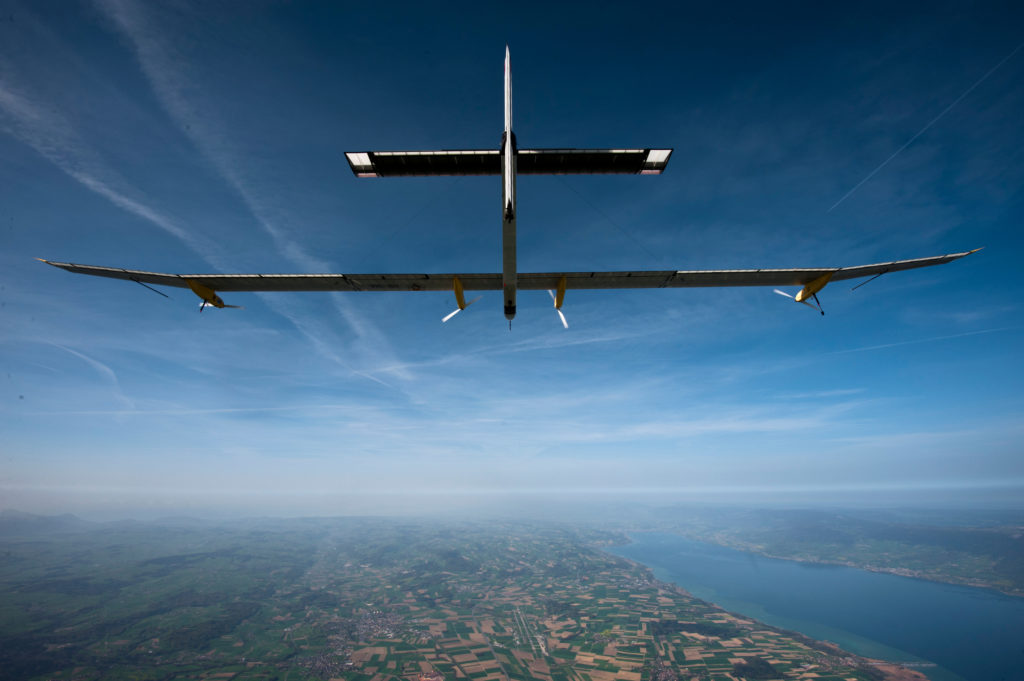Around the world on pure light
Today’s aviation pioneers have a different set of challenges. One of the greatest is improving the fuel efficiency of aircraft. But what if we could fly using the sun’s energy?
That idea inspired Bertrand Piccard – one of the first people to fly non-stop around the world in a balloon. Landing after the successful 1999 mission, the team realised that of the 3.7 tonnes of liquid propane they started with, just 40 kg remained. “It made me very aware of our dependency on fuel,” said Piccard. “I promised myself that the next time I flew around the world, it would be without fuel.”
Just four years later, Piccard launched the Solar Impulse project. The goal – a solar powered aircraft that could fly around the world, powered only by the sun and which can store enough power to fly by night.
The first SolarImpulse prototype (designated HB-SIA) first took to the sky in late 2009. Since then the aircraft has amazed the public and confounded the critics on a series of demonstration and night flights (on batteries charged by light energy) across Europe, Africa and North America.
The aircraft gathers energy through 11,628 silicon solar cells which cover the wing and tail. These small, lightweight, energy-generating units are created using silicon purified through chlorine chemistry. Similar technology is used to create integrated circuits, the foundation of modern computer technology and an important component of Solar Impulse’ onboard circuitry.
Carbon-fibre reinforced polymer (CFRP) forms most of SolarImpulse’s surface and structural elements. The CFRP consists of a matrix of carbon fibres reinforced with a polymer resin created through chlorine chemistry. The combination of the matrix and resin form a material with very high tensile strength, but extremely low weight. Even lighter weight CFRP will be deployed on the next Solar Impulse prototype currently under construction (see box).
The journeys that Solar Impulse has made to date have served to prove that Bertrand Piccard’s dream of flying without fuel is certainly possible. The aircraft has even flown for over 26 hours straight, demonstrating that it can generate enough energy to power itself through the night. With the knowledge gained and new advances in technology, it can only be a short time until Piccard sets out on his next successful round-the-world flight!
First solar-powered around the Planet flight
After the Solar Impulse prototype’s eight world records, when it became the first solar airplane ever to fly through the night, between two continents, and across the United States, it is time for Bertrand Piccard and André Borschberg to move on to the final phase of the adventure: the 2015 round-the-world flight.
The route: Si2 took-off from Abu Dhabi, capital of the United Arab Emirate, on March 9th ready for its 35,000km voyage. The route included stops in Muscat, Oman; Ahmedabad and Varanasi, India; Mandalay, Myanmar; and Chongqing and Nanjing, China. After crossing the Pacific Ocean it landed in Hawaii, and after some modification, Si2 will fly across the Continental U.S.A. stopping in three locations – Phoenix, and New York City at JFK. After crossing the Atlantic, the final legs include a stop-over in Southern Europe or North Africa before arriving back in Abu Dhabi. The trip included a 11 7hour and 52 minute non-stop flight over the Pacific Ocean, a new record!
In addition to the 17428 photo-voltaic cells, the use of modern materials such as polyurethane (also a chlorine thing) has helped in its manufacture. Polyurethane has been used to insulate the cabin and batteries (against the large variations in temperature from +40 to -40deg C) as well as in adhesives on the wings and silver coatings that give the plane it’s distinctive look.
The plane has a wingspan greater than that of a Boeing 747 but is lighter than a family car, weighing only 2300kg. Indeed, due to these modern materials, the cabin was increased by a factor of 3 but only added 2kg on to the additional weight of the plane. We cannot wait to hear more about this exciting piece of technology when it takes to the skies again soon.
Read more about the SolarImpulse aircraft

